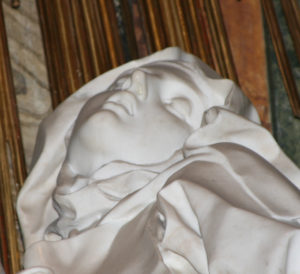Teresa of Avila – Mystic or Reformer?
Teresa of Avila gets a bad rap these days, for many people picture her in a state of rapture or levitating. Bernini’s statue in Rome, “The Ecstasy of Teresa,” beautiful though it is, reinforces that view. But visions, ecstasies, and locutions (her word for hearing God) make up only part of Teresa’s spiritual life and shouldn’t be the main focus, for they should act as markers or pointers to the transformation of her soul.
After all, her highest state of union, which she describes in the seventh mansions in The Interior Castle, considered her greatest work, is not rapture but spiritual marriage with the Trinity. She senses in an intellectual vision this union, with each member of the Trinity playing its own role, and her as the beloved. The “favors,” which is what Teresa called the divine revelations of visions and ecstasies, therefore empower the soul to live like Christ, empowered to go out and do good works. Plenty of which Teresa did.
She was deeply concerned for reform within the Carmelites, and set up the Discalced (or Barefoot) Carmelites in the response to the excesses she discerned – social hierarchies in the convents, gossip, wealth… She wanted them to return to the values of simplicity and poverty, and to empower her sisters she wanted to teach them mental prayer (in contrast to vocal prayer, which would be practiced in community). Later she convinced John of the Cross to join the movement (she was thirty years his senior, but for a time he became her confessor).
But this was the time of the Inquisition in Spain (the sixteenth century), for King Ferdinand and Queen Isabella had sought the unity of the country through the Catholic faith. Therefore anyone who didn’t convert – Muslims and Jewish people – were exiled, and those who did convert were assessed as to the purity of their beliefs. The Inquisition viewed mental prayer as dangerous and undermining the institutional church, and writing that promoted it was taken away to be considered and perhaps banned. Teresa’s own copy of The Book of Her Life, her autobiography, was taken and never returned to her. She wanted to teach her fellow nuns so her confessor encouraged her to write new works, which resulted in several books including The Interior Castle.
Her work as a reformer included a keen desire that the nuns under her care would be transformed through union with the triune God through prayer. The journey of love she recounts in The Interior Castle is one of journeying ever closer to God’s heart. May we too live in the mansions God has prepared for us, dwelling with him and enjoying his love.
This blog post comes from thinking I’ve been doing for an essay for the “History of Christian Mysticism to the Reformation” course I’m taking at Heythrop College, University of London. This term I’ve read some amazing and mind-boggling thoughts from people such as Augustine, Origen, Bernard of Clairvaux, Hadewijch, and Teresa and John of the Cross. It’s been fun, intense, hard, and stretching.









 Hello!
Hello! 
I really enjoyed find out more about Teresa of Avila! Thanks!